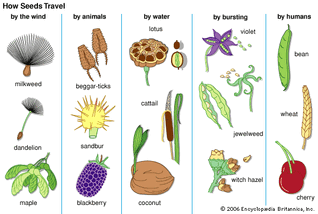
Allopatric Speciation and Dispersal
Video copied from youtube http://www.youtube.com/watch?v=-gC6JisW3pY
Dispersal describes when members of a select population cross a geographic barrier and establish a new population (Purves, Sadava, Orians, & Heller, 2004). Dispersal can be driven by several different factors including but not limited to the search for a better more sustainable habitat. Along these lines, dispersal can also describe the movement of young away from the area they were born to avoid competition for mates and resources with their parents (Norris, Flockhart, & Strickland, 2013).

Here are some methods plants use to disperse their seeds
Role in Speciation[]
Unrestricted gene flow generally leads to homogeneity of alleles across a population and limits opportunities for speciation (Freemon & Herron, 2007). Restricted gene flow can set the stage for speciation and is often a product of geographic isolation. Dispersal can lead to geographic isolation which is one key factor in the allopatric model of speciation. Although dispersal contributes to ideal conditions for speciation, it is not the actor that causes populations to diverge. The true actors are natural selection and genetic drift (Futuyma, 2009).
Evolution Through Dispersal[]
Research suggests that early parrot lineages occupied parts of Antarctica on the super continent of Gondwana. As global temperatures began to cool and Antarctica started to break off from the super continent, it is suggested that these parrot species moved through transoceanic dispersal to both Africa and the Neotropics (Schweizer, Seehausen, Hertwig, & 2011). This dispersal is credited as a major event leading to the speciation of all modern neotropical parrots (members of the family Psittacidae).
References[]
Freeman, S. Herron, J. (2007). Evolutionary Analysis (4th ed.). Pearson Education Inc.
Futuyma, F.J. (2009). Evolution (2nd ed.). Chapter 11. Retrieved from http://ncse.com/files/pub/evolution/Evolution--Futuyma--chap11.pdf
Norris, R., Flockhart, T., Strickland, D. (2013). Contrasting patterns of survival and dispersal in multiple habitats reveal an ecological trap in a food-caching bird. Oecologia, 173, 827-835. doi: 10.1007/s00442-013-2680-1
Purves, W., Sadava, D., Orians, G., Heller, H. C. (2004). Life the Science of Biology (7th ed.). Sunderland, MA: Sinauer Associates, Inc.
Schweizer, M., Seehausen, O., Hertwig, S. (2011). Macroevolutionary patterns in the diversification of parrots: effects of climate change, geological events and key innovations. Journal of Biogeography, 38, 2176-2194. doi: 10.1111/j.1365-2699.2011.02555.x